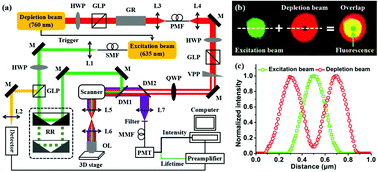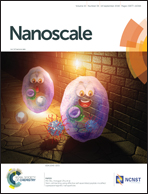Resolution improvement in STED super-resolution microscopy at low power using a phasor plot approach†
Abstract
Stimulated emission depletion (STED) microscopy is a powerful super-resolution microscopy technique that has achieved significant results in breaking the resolution limit and relevant applications. In principle, STED super resolution is obtained by stimulated emission partially inhibiting the spontaneous emission in the periphery of a diffraction-limited area. However, very high depletion laser power is generally necessary for the enhancement of imaging resolution, which is harmful to live biological specimens due to its high phototoxicity and photo-bleaching effects. Therefore, further improving the STED resolution at a lower depletion power level has recently attracted increasing interest from researchers in various fields. In this work, a phasor plot approach combined with fluorescence lifetime imaging microscopy (FLIM) is used to resolve the abovementioned problem based on a long- and short-lifetime criterion. Firstly, the time-resolved data obtained by STED-FLIM is converted to the frequency domain via a phasor approach. Next, partial data is extracted according to the information on the phase and amplitude for resolution improvement. Then, fluorescent microspheres (100 nm in diameter) are observed under different depletion powers, resulting in a series of improved resolution through phasor plots. Finally, this method is applied to image human Nup153 in fixed HeLa cells, providing a 86 nm higher resolution than that in traditional STED imaging at a depletion power of 20 mW.



 Please wait while we load your content...
Please wait while we load your content...